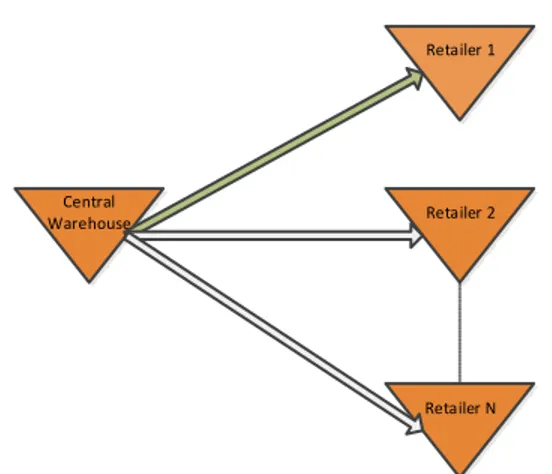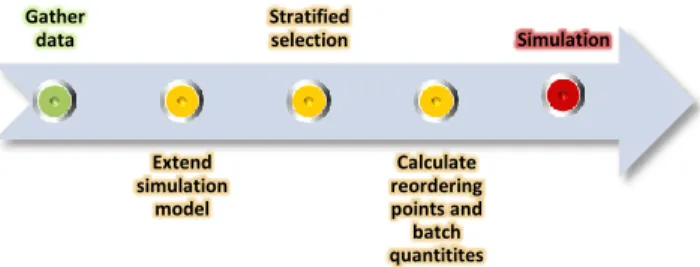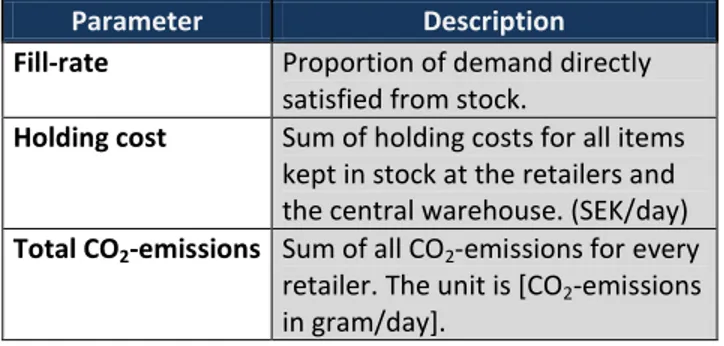Environmental and Economic Benefits of
using Multi-Echelon Inventory Control
- A case study
Sven NilssonLina Ottosson
Lund University, Faculty of Engineering The Division of Production Management
By controlling a one-warehouse-multi-retailer inventory system with a new multi-echelon inventory control method instead of a single-echelon control method, environmental and economic benefits can be obtained. In this case study a multi-echelon control model developed at the division of Production Management, Lund University, Faculty of Engineering (denoted MEM by the authors) is compared to a commercial single-echelon model (denoted SCP). The SCP model is the current method used to control the inventory at the case company. This case study evaluates the possible improvement of service levels, reduction of transportation related CO2-emissions, and the holding costs reduction when using the MEM model instead of the SCP model to determine the reorder points. The evaluation was performed in a simulation environment named Extend. One of the contributions of this project is the extension of a currently available simulation model to incorporate emergency orders.
The results show that the average fill-rate was increased by 8.3%, the weighted average fill-rate based on average demand per time unit was increased by 34.39%, the holding costs went down by 18.1% and the CO2-emissions were reduced by 57.0%. Sensitivity analysis of the results concerning the CO2-CO2-emissions show that the mode of transportation used for emergency orders has large impact on the result. At the same time, the input parameter for CO2-emissions caused by air transports has a relatively small impact on the inventory system studied in this case. The reason is that the proportion of air transports compared to all emergency transports in the system is small. The conclusions from the results are that using the MEM model instead of the SCP model has a large potential to achieve both environmental and economic benefits.
1. BACKGROUND
More and more companies are showing interests in being “environmentally friendly“. The topic of global warming is on the corporate agenda and there are restrictions on energy consumption, such as the Emission Trading Scheme (EEA, 2012). Considering this, an interesting point of view is to study the possible reductions of CO2-emissions that can be rendered by implementing multi-echelon
control of an inventory system instead of single-echelon control.
Inventory systems with several stock-points that supply one another are in the inventory management literature called stage or multi-echelon inventory systems since they include several stages with interlinked inventories. The type of system studied in this master thesis is a distribution inventory system with divergent flow,
more precisely explained as a one-warehouse-multi-retailer system, see Figure 1.
Central Warehouse
Retailer 1
Retailer 2
Retailer N
Figure 1. Two-echelon distribution inventory system.
From now on the terms multi-echelon inventory system and one-warehouse-multiple-retailers system will be used synonymously. When controlling a multi-echelon inventory system, there are two types of control methods which in this paper are referred to as single-echelon control and multi-echelon control. Single-echelon control is a method where the interdependencies between the different stock locations are not taken into consideration, and each echelon is controlled independently of all the other locations. A multi-echelon inventory control method instead tries to capture the interdependencies to optimize the whole system.
The possibility to reduce the inventory levels and at the same time better achieve target fill-rates by using multi-echelon inventory control instead of single-echelon inventory control have earlier been evaluated, among others by Berling and Marklund (2012; 2013). The result from the numerical studies in these two papers shows that their multi-echelon control method reduces the inventory level in the system, and at the same time improves the target fill-rates towards the customer. Consequently, there are already strong indications that a multi-echelon model can control a multi-multi-echelon inventory system with both better service and
lower costs. In this study the environmental impact of the inventory system is evaluated in addition to the investigation of the fill-rate and the economic benefits. The environmental impact is a new point of view for the multi-echelon system studied in this project. Environmental impact is in this study defined as emissions of transportation related CO2-equivalents, as this is the metric used by the case company. (Hersner, 2013)
The case company studied in this project was Lantmännen Maskin, a company that sells agricultural machinery and equipment, and also delivers spare parts for these products. Today the company plans their inventory system using a single-echelon control method. When there is shortage of critical items emergency orders are used. Those mean faster but more expensive deliveries than for regular orders. (Hersner, 2013) By improving the fulfillment of target fill-rates with the use of the MEM method the need to send emergency orders is reduced. Since emergency orders emit more CO2 than regular orders the multi-echelon control model has a potential to reduce the environmental impact of the inventory system studied. The question is to what extent?
The single-echelon inventory control method currently used at Lantmännen Maskin (denoted SCP) is the base line for evaluating the considered multi-echelon inventory control model. The SCP model is compared to a new multi-echelon inventory control model developed at the division of Production Management, Lund University, Faculty of Engineering, denoted MEM in this article. The study was restricted to only include historical demand data for spare parts sold by Lantmännen Maskin. Since only the internally owned retailers are obliged to use the software with SCP where data is stored, the study was also limitated to these retailers.
2. PURPOSE
The purpose of this project is to evaluate the environmental and economic benefits of using more advanced multi-echelon inventory control instead of the current single-echelon inventory control method at Lantmännen Maskin. Particularly, the impact that improved fulfillment of fill-rate targets can have on reducing emergency orders and their associated costs and CO2-emissions will be evaluated. The impact on CO2-emissions related to freight transportation and the economic gains from reduction of inventory holding costs will be in focus.
3. METHODOLOGY
The workflow of this thesis project is illustrated in Figure 2. The first step was to gather data from the case company, both from interviews but also from current data-bases, for example to attain historical demand data. This data was then analyzed to see what type of information was available and what was not.
To evaluate the CO2-emissions at Lantmännen Maskin according to the MEM method and the SCP method, discrete event simulation in the software Extend was used. A basic simulation model was already available at the division of Production Management at Lund University, Faculty of Engineering. This model has been used in several earlier studies to simulate multi-echelon inventory systems. The basic model did not incorporate emergency orders and therefore this was added
during the project. This was one of the critical parts of this study and is part of this project’s contributions. To be able to model the emergency orders appropriately, the situations generating emergency orders were identified during an interview with Lantmännen. It was very important to first gather the data about the system since the issue of emergency orders can vary depending on the company studied.
When the simulation model was extended and the data was gathered, a selection from the entire data sample of items needed to be performed. The approach chosen was to use a stratified selection as opposed to a complete random selection. The reason for this was that by using stratified selection it can be assured that certain parameters and characteristics are represented in the final sample of items. The characteristics used for the stratified selection were:
Standard deviation divided by the mean, Mean demand
Cost of product
Geographical location of transaction Weight
From the different strata based on these characteristics, 106 items were chosen.
The final step before conducting the simulations was to calculate the batch quantities and the reorder points for the two different methods; SCP and MEM. The batch quantities for the two methods were calculated according to the current procedure used at the case company. The multi-echelon and single-multi-echelon reorder points were calculated according to the MEM and SCP model respectively.
4. THEORETICAL FRAMEWORK
The SCP model corresponds to the current method used at Lantmännen Maskin whereas the MEM
Gather data Extend simulation model Stratified selection Calculate reordering points and batch quantitites Simulation
model is specified in Berling and Marklund (2012; 2013). Both models are used on a multi-echelon inventory system which fulfills the following criteria:
(R,Q)-policies are used at all stock points. All shortages are backordered at every
stock point in the system.
Orders and demand are handled with a first-come-first-served policy.
The transportation time between the central warehouse and the retailers are constant.
The inventories at the outside supplier are infinite meaning that there will never be a stock-out there. Consequently, the lead-time between the outside supplier and the central warehouse is assumed to be constant.
The essential difference between the SCP model and the MEM model is that the latter captures the interdependencies between different stock-points whereas the SCP does not. The SCP model treats each echelon independently from all other echelons. As a consequence, the actual fill-rate (in the real system) when single-echelon control is used is often lower than what the model predicts. If the system instead is modeled by the MEM model, it approximates and incorporates the interdependencies into the model. By using the MEM model the fill-rate fulfillment in the simulations are much better than with the SCP model.
The MEM model (Berling and Marklund (2012; 2013)) uses an approach were the multi-echelon inventory system is decomposed into several single-echelon inventory systems. This means that the interdependencies are approximated and incorporated in the optimization of the decomposed multi-echelon system. By using this method of decomposing the inventory system the
calculations will be fast and can be applied to real life inventory systems with thousands of items. Previous studies also indicate that the performance of this model is quite good.
The fact that multi-echelon control of an inventory system lowers the costs compared to single-echelon control has been well documented. However, the possibility to reduce CO2-emissions by using multi-echelon control has not. As the purpose states, this study aims at investigating both the economic and environmental benefits of multi-echelon inventory control compared to single-echelon control. To evaluate the different transportation modes i.e. regular and emergency transports on CO2-emissions, a combination of theory and gathered real life data was used. The environmental theory used is obtained from Network for Transport and Environment (NTM 2010; NTM 2011), who has researched methods for calculating CO2-emissions from different transportation modes, vehicles types and load utilizations. The regular transports by truck are in full calculated according to the methods of NTM. Regarding the emergency transports by truck the actual CO2-emissions have not been used since the load utilization for these transports are hard to estimate. For emergency transports by air the values per kilogram transported goods was gathered from Posten (2013) and Jetpak (2013). To these values the emissions from regular transports by truck to and from the airport was added. These figures were also compared to theoretical values calculated with the method of NTM to investigate the accuracy.
5. RESULTS
The results from the simulations in terms of average differences between the MEM model and the SCP model are displayed in Table 1. The parameters are described in Table 2 below.
Table 1. Results from the simulations. Fill-rate (average) Fill-rate (demand weighted average) Holding Cost (SEK) Total CO2-emissions (g) SCP 91.94% 73.22% 169.25 305.52 MEM 99.58% 98.40% 138.55 131.41 Diff (%) 8.31% 34.39% -18.14% -56.99%
Mean Target Fill-rate 98.76%
Table 2. Description of the result parameters.
Parameter Description Fill-rate Proportion of demand directly
satisfied from stock.
Holding cost Sum of holding costs for all items kept in stock at the retailers and the central warehouse. (SEK/day)
Total CO2-emissions Sum of all CO2-emissions for every
retailer. The unit is [CO2-emissions
in gram/day].
With multi-echelon control instead of single-echelon control the inventories in the system tend to be pushed downstream towards the retailers instead of upstream to the central warehouse. This may lead to increased amount of items in stock at the retailers while the stock level at the central warehouse instead is reduced. As an effect of using multi-echelon control instead of single-echelon control in this case study, the fill-rate at the retailers are increased by 8.31% calculated as a average across items and retailers and with 34.39% if a demand weighted average is used. The fill-rate is only measured at the retailers since the service need to be high for the external customer but not for the internal customers (the retailers). The fill-rate at the central warehouse is in general significantly reduced for the MEM model solution compared to the SCP solution. This is because the MEM model only tries to fulfill the target fill-rates to the customers and uses the central warehouse as a stock point for optimizing the entire inventory system.
The holding costs are affected by the total value of articles kept in stock. Thus it is decreased when the total stock at all retailers and the central warehouse is decreased. For the items simulated, the total holding costs decreased by 18.14% on average when comparing the MEM solution with the SCP solution.
The transportation cost is also affected by the emergency shipments since emergency orders normally have higher transportation costs than regular orders. This is primarily due to less utilization of transport space and more expensive means of transportation. The transportation costs affect the total cost reduction when comparing the MEM model with the SCP model. By incorporating this into the calculations it would be possible to show more cost reductions.
The improved fulfillment of target fill-rates obtained from the MEM model results in a decreased need of sending emergency items. By sending less emergency orders, the CO2-emissions of the inventory system can be reduced. For the simulated items the total amount of CO2-emissions for transportation in the inventory system was decreased by 56.99%.
Since the information about CO2-emissions for air transports varied considerably depending on the source used, sensitivity analyses were performed on the CO2-input parameter. The results show that the total CO2-emissions in the transportation system are only slightly affected when the CO2-input value for emergency orders by air is changed. A five times bigger value than the minimum barely increased the CO2-emissions from the system. The reason for this is that the amount of emergency orders per day sent by air is much lower than the amount of emergency orders sent by truck.
Calculations were also done where all emergency deliveries in the system were transported by air.
This analysis was performed to investigate how the mode choice for emergency transport will affect the total CO2-emissions. This test indicates that if all emergency orders in the system would be sent by air the CO2-emissions may be decreased by as much as
90.82
% by using the MEM model.6. CONCLUSIONS & RECOMMENDATION
The purpose of this research was to evaluate the environmental and economic benefits that could be attained from using the MEM model instead of the SCP method currently used by the case company. The purpose was especially aimed at evaluating the impact of emergency orders. The results show that for the selected sample of representative products, the MEM model increases the average fill-rate by 8.31%, increases the demand weighted average fill-rate by 34.39%, decreases the holding costs by 18.14%, and reduces the CO2-emissions by 56.99%. Consequently, the MEM model appears to be a good choice from an environmental perspective and the beauty of it is that at the same time the service is improved and the costs are significantly reduced. This confirms the hypothesis that a better fill-rate fulfillment will have a positive environmental impact. Even though one cannot with certainty generalize these figures to other systems they strongly indicate that implementing multi-echelon inventory control with better precision in predicting achieved fill-rates can reduce CO2-emissions associated with emergency orders and thereby benefit the environment.
7. REFERENCES
BERLING, P. and MARKLUND, J., 2012. Multi-Echelon Inventory Control – A Normal Demand Model for Implementation in Practice. Working paper, Lund University.
BERLING, P. and MARKLUND, J., 2013. A model for heuristic coordination of real life distribution inventory systems with lumpy demand. European Journal of Operational Research, forthcoming.
EUROPEAN ENVIRONMENT AGENCY, 2012-last update, GHG trends and projections in the EU-27. [Homepage of European Environment Agency], [Online]. Available:
http://www.eea.europa.eu/publications/ghg-trends-and-projections-2012 [01/14, 2013]. HERSNER, C., 2013. Interview.
JETPAK, 2013. Mail correspondence.
NATIONALENCYKLOPEDIN, 2013, Kyotoprotokollet [Homepage of Nationalencyklopedin], [Online]. Available:
http://www.ne.se.ludwig.lub.lu.se/lang/kyotoproto kollet [01/14, 2013].
NETWORK FOR TRANSPORT AND ENVIRONMENT, 2010. ENVIRONMENTAL DATA FOR
INTERNATIONAL - ROAD transport Europe. 4. Network for Transport and Environment.
NETWORK FOR TRANSPORT AND ENVIRONMENT, 2011. ENVIRONMENTAL DATA FOR
INTERNATIONAL CARGO AND PASSENGER AIR TRANSPORT Network for Transport and Environment.


